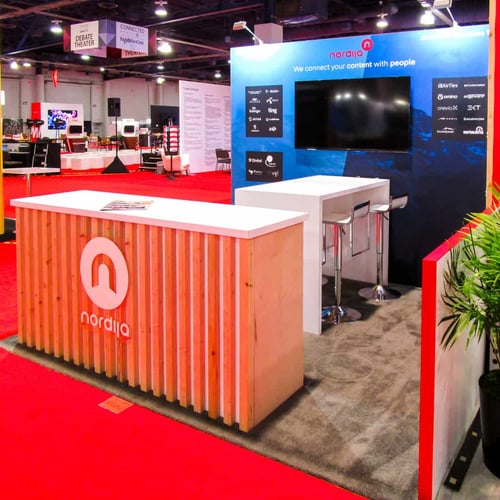A trade show display doesn’t have to be big to be effective. Smaller booths — 10x10 to 10x20 in size — can still make an impact if you plan ahead and are strategic with your design. They can also be an effective option for new or budget-conscious exhibitors alike.
When it comes to small booth design, consider these best practices for maximizing your space.
1. Portable or Modular vs Custom-Designed Exhibit Booths
One key factor when it comes to smart booth design is considering whether you want a portable or modular design — or something fully customized.
The benefits of portable and modular trade show booths start with a lower cost and easier set-up. These displays can easily fit into a 10x10 booth space, yet still allow for an eye-catching, branded backdrop. Plus, they are easily transported from place to place, saving costs on delivery services to and from trade show locations.
On the other hand, custom-designed exhibit booths are fabricated specifically for your company and brand. Based on your goals for the trade show, the custom design may include distinctive lighting, unique structural features, interactive elements, and other strategic presentation components.
2. Best Practices for Small Trade Show Booths
Don’t let a small space hold you back in terms of strategy and creativity. Follow these best practices to maximize your space.
- Start with your main objective for exhibiting. Trade shows are big commitments that require a multitude of resources. Identify your primary objective and the metrics that will gauge your success, as well as guide you throughout the planning process.
The most common reasons for exhibiting include: - Lead generation
- Product or service launch
- Maintaining an industry or market presence
- Location, location, location. Be strategic and reserve your booth space early. For example, corners and intersections get great foot traffic, as you can take advantage of the movement coming from multiple directions.
- Follow the rules. Take the time to carefully review the exhibitor manual and familiarize yourself with the guidelines for display rules and regulations. You’ll need to know your space limitations, the guidelines for booth materials, any design requirements, shipping rules, and more.
- Be strategic with your layout. Once you understand the parameters, consider how you can maximize your space. Try to keep the front of your space clear of furniture and unnecessary clutter, as this will open up the appearance of your small booth. One example of a clean, modern and attractive booth design is Nordija, who used bright colors, straight lines, and a modern aesthetic to attract visitors.

- Plan for proper staffing. When it’s time to discuss staffing needs, consider the guests' experience. Where will show attendees enter your booth, and how many people will you need to adequately respond without overcrowding? Smaller spaces require fewer staff, but this means everyone must be available, energetic, and on-point to best represent your company.
- Creativity is key. Even in a small space, there’s plenty of room for creativity. Special graphics and careful use of color can work wonders when it comes to the emotional response to your booth. Consider how special lighting can also affect the overall mood and look of your space.
When partnering with an experienced exhibit house, their design team will advise on what will work for your smaller space, and provide ideas to help you get noticed on the expo floor.
Take it to the Next Level
Think of your trade show display as a blank canvas — and remember that some of the best art exists within modest frames. Your display booth strategy can be totally effective and memorable even within a 10x10 to 10x20 trade show booth.
Looking for more inspiration? Check out our design portfolio for ideas.
Ready to get started with Exhibit Options? Contact us today.



COMMENTS